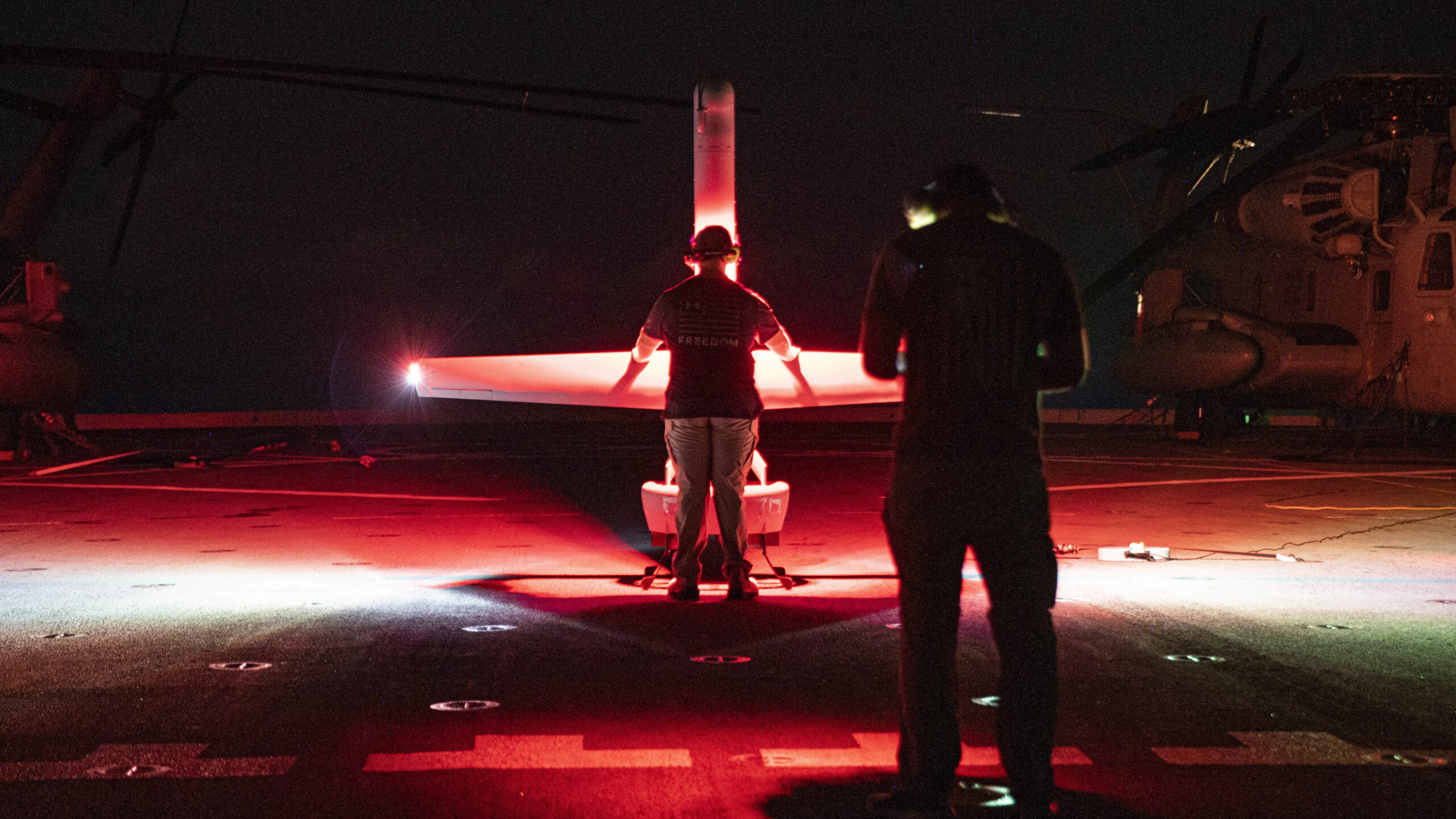
Unmanned aerial vehicle operators supporting the 11th Marine Expeditionary Unit prepare to launch a VBAT Unmanned Aerial System aboard amphibious transport dock USS Portland on Sept. 5, 2021. (US Marine Corps/Sgt. Alexis Flores)
WASHINGTON: A small San Diego-based startup is developing artificial intelligence software that could put the US Air Force one step closer to fielding swarming drones and autonomous electric rotorcraft.
Shield AI announced late last month that it received an Air Force contract worth up to $60 million for a series of projects involving the company’s Hivemind autonomy stack, a common AI system the company is developing to control everything from small drones to — potentially one day in the future — fighter jets like the F-16.
First, Shield AI will integrate Hivemind with multiple V-Bat drones also made by the company, its cofounder Brandon Tseng told Breaking Defense in an interview. After that, it could get the green light to start doing foundational work to put Hivemind on Beta Technologies’ ALIA electric vertical takeoff and landing (EVTOL) aircraft.
While the US military has had development programs for swarming drones — such as expendable Perdix drones or air-launched Gremlins — Shield AI has focused on optimizing its autonomy stack so that an individual drone is intelligent and can learn from experiences in the field.
“Instead of having a team of peewee football players, let’s build a single professional athlete and then multiply that professional athlete across the team and have them work together,” Tseng said.
The goal is to have swarms of three to five V-BAT drones ready for operation and production by the end of 2023, and to gradually increase the size of the swarm to about 10 V-BATs in 2024 and to up to 30 drones in 2025.
“I think people will be shocked and surprised at the speed that they can actually employ an operational swarm to great effect,” he said.
If successful, the Air Force could approve the next phase of the contract, where Shield AI would begin doing foundational simulation work to make Beta Technologies’ ALIA a fully autonomous aircraft.
Through its Agility Prime effort, the Air Force is working with commercial EVTOL providers as they mature electric rotorcraft meant to shuttle people across cities, one day making an air-based version of Uber a reality. The Air Force sees a different potential application for EVTOL aircraft, such as autonomously shuttling troops, transportation equipment or picking up injured servicemembers on a battlefield.
While Tseng believes the integration of Hivemind would yield obvious benefits for the US military, he noted that it will also aid EVTOL startups as they look to create a commercial market for short-distance air transport.
“Our conversations with a lot of these companies in the EVOTL space has been, ‘We need autonomy to really make the business model work in the [commercial] market,’” he said. “If we have two pilots for an aircraft or one pilot for an aircraft, the economics aren’t going to work out. We won’t all have our flying taxis unless we have highly reliable autonomous systems.”
The Air Force awarded this latest contract through the Strategic Funding Increase (STRATFI) Program, a special funding agreement that allows the service to quickly allot money to a company for projects that can help firms scale the gap between Small Business Innovation Research phase 2 and 3 contracts. At the same time, US government investments must also be matched by private investment.
The work on Hivemind supports AI for small unit maneuver, one of Air Force Special Operations Command’s top five innovation initiatives, Shield AI said in a news release.
“The AFWERX STRATFI with Shield AI will advance the autonomous collaboration capabilities of AFSOC’s UAS, enabling them to team with Air Commandos in complex environments,” Brig. Gen. Justin Hoffman, Air Force Special Operation Command’s director of strategic plans, programs and requirements, said in a statement. “Human-machine teaming is a critical capability for AFSOC’s broader transformation for strategic competition.”
Since its founding in 2015, Shield AI has acquired a number of companies focused on artificial intelligence and uncrewed aircraft. In 2021, it bought Heron Systems — the company whose AI defeated a human F-16 pilot in DARPA’s Alpha Dogfight trials — and Martin UAV, which makes the V-Bat.
The company, which employs about 360 people today, is set to grow to almost 500 employees by the end of 2022, Tseng said.






















